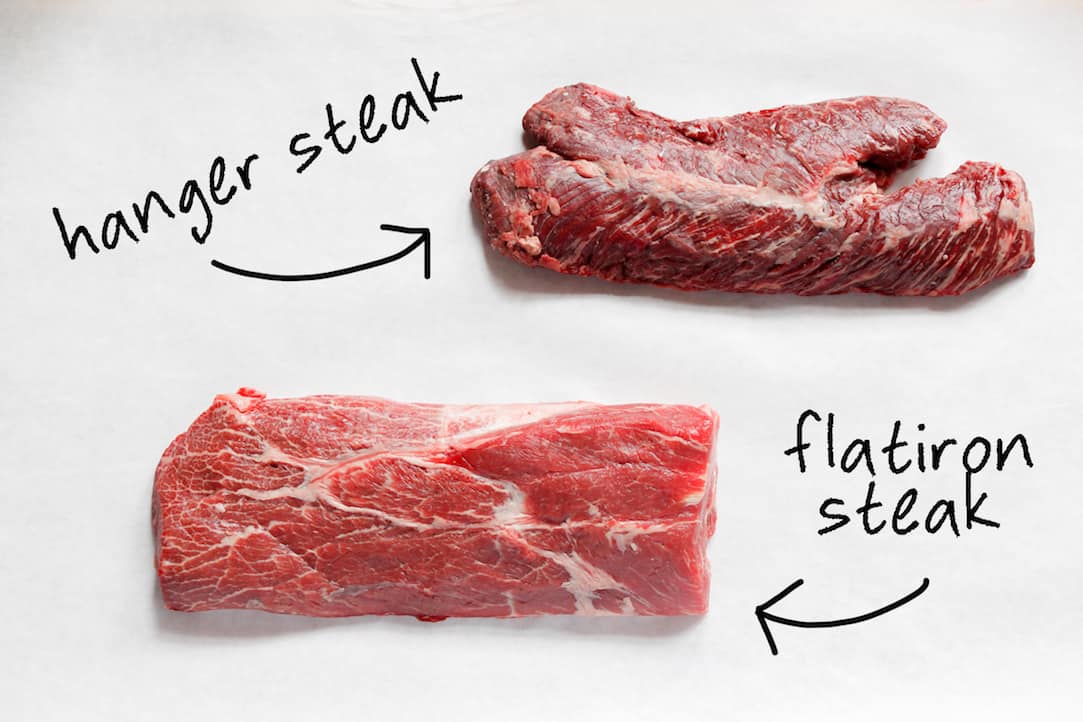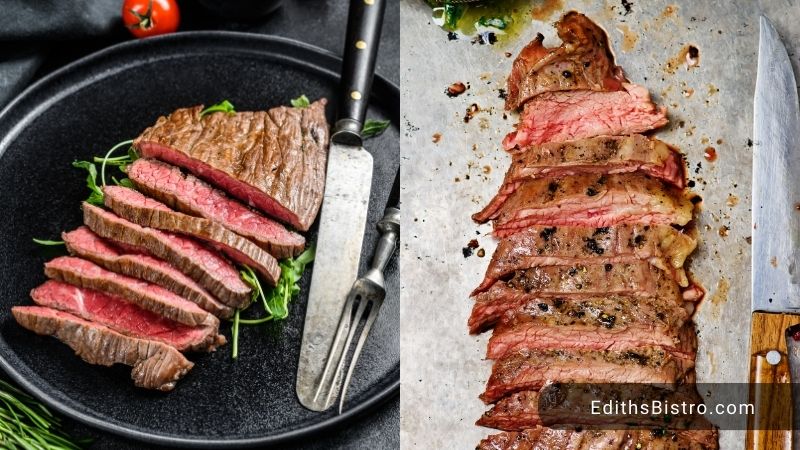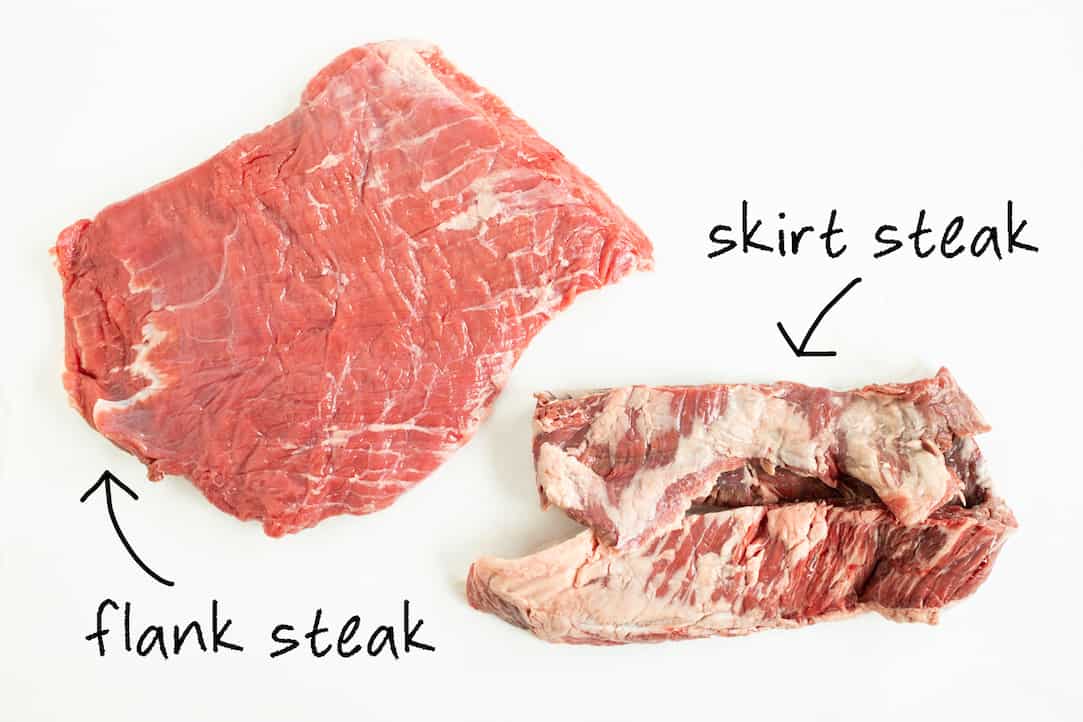Introduction

In the world of beef cuts, the battle between flank and flat iron steak is fierce. Both cuts have their own unique characteristics, flavor profiles, and cooking methods. Understanding the differences between these two steaks can help you make an informed decision when choosing which one to bring to your dining table. In this article, we will explore the definitions, characteristics, and cooking techniques for both flank and flat iron steak. We will also compare their texture, tenderness, flavor, and marbling. So, let’s dive into the world of flank vs flat iron steak and discover which one reigns supreme on your plate.
Background And Overview Of Flank Vs Flat Iron Steak
Flank steak and flat iron steak are two popular cuts of beef that offer different flavors and textures. Flank steak is a lean and flavorful cut that comes from the abdominal muscles of the cow. It is known for its long, flat shape and pronounced grain. On the other hand, flat iron steak is obtained from the shoulder area, specifically the top blade muscle. It is a tender and well-marbled cut that is rectangular or flat-shaped. Both cuts have their own unique characteristics and cooking methods, making it important to understand their differences when preparing a delicious steak dish.
Flank Steak
Flank steak is a lean and flavorful cut of beef that is highly versatile in various dishes. It is sourced from the abdominal muscles of the cow, resulting in a long and flat shape with a noticeable grain. This cut is known for its rich beefy flavor and slightly chewy texture. Flank steak is best cooked quickly over high heat to retain its tenderness and juiciness. It is commonly used for grilling, stir-frying, or marinating and can be served as a main dish or sliced thin for sandwiches and salads.
Flank Steak: Definition, Characteristics, And Cooking Methods

Flank steak is a lean and flavorful cut of beef sourced from the abdominal muscles of the cow. It is famous for its rich beefy flavor and slightly chewy texture. This long and flat steak has a noticeable grain running through it. Due to its texture, flank steak is best cooked quickly over high heat to retain its tenderness and juiciness. It is perfect for grilling, stir-frying, or marinating. Some popular cooking methods include broiling, pan-searing, or grilling it to medium-rare or medium doneness. Flank steak is often used in dishes like fajitas, stir-fries, or served as a carved steak.
Flank Steak: Flavor Profiles And Recommended Recipes
Flank steak is known for its rich beef flavor, making it a popular choice for many delicious recipes. Its slightly chewy texture adds a delightful mouthfeel to dishes. Here are some flavor profiles and recommended recipes for flank steak:
- Asian-inspired: Marinate flank steak in a mixture of soy sauce, garlic, ginger, and sesame oil. Grill or stir-fry the steak and serve it with steamed vegetables and rice or noodles.
- Tex-Mex style: Create flavorful fajitas by marinating flank steak in lime juice, cumin, chili powder, and garlic. Grill or pan-sear it, then slice thinly and serve with tortillas, peppers, onions, and your favorite toppings.
- Italian flair: Make a delicious balsamic flank steak by marinating it in balsamic vinegar, Dijon mustard, garlic, and herbs like rosemary and thyme. Grill it to perfection and serve with roasted vegetables or a fresh salad.
- Korean BBQ: Try a Korean-style flank steak by marinating it in a mixture of soy sauce, brown sugar, ginger, and garlic. Grill or broil it and serve with steamed rice, kimchi, and pickled vegetables.
- Salad topping: Slice grilled flank steak and add it to a refreshing salad with mixed greens, cherry tomatoes, cucumbers, and your choice of dressing.
These recommended recipes showcase the versatility and delicious flavor of flank steak, allowing you to explore different cuisines and enjoy a satisfying meal.
Flat Iron Steak
Flat Iron Steak is a flavorful cut of beef that comes from the shoulder area of the cow, specifically from the top blade muscle. It is known for its tenderness and rich marbling, which gives it a juicy and flavorful taste. The flat iron steak is versatile and can be cooked using various methods such as grilling, broiling, or pan-searing. It is best cooked to medium-rare or medium to ensure optimal tenderness and juiciness. This cut of steak is perfect for steak lovers who appreciate a balance of tenderness and flavor in their meal.
Flat Iron Steak: Definition, Characteristics, And Cooking Methods

Flat Iron Steak is a flavorful cut of beef that comes from the shoulder area of the cow, specifically from the top blade muscle. It is known for its tenderness and rich marbling, which gives it a juicy and flavorful taste. The flat iron steak is versatile and can be cooked using various methods such as grilling, broiling, or pan-searing. It is best cooked to medium-rare or medium to ensure optimal tenderness and juiciness. This cut of steak is perfect for steak lovers who appreciate a balance of tenderness and flavor in their meal.
Flat Iron Steak: Flavor Profiles And Recommended Recipes
Flat Iron Steak is known for its rich flavor and tenderness. Its marbling and deep beefy taste make it a favorite among steak lovers. The flavor profile of Flat Iron Steak is often described as bold, robust, and intense. It pairs well with various seasonings such as garlic, rosemary, and pepper. Some recommended recipes for Flat Iron Steak include marinating it in a soy sauce and ginger mixture, grilling it with a chimichurri sauce, or pan-searing it with a black pepper crust. These recipes enhance the natural flavors of the steak and create a delicious and satisfying meal.
Comparing Flank And Flat Iron Steak
When comparing Flank and Flat Iron Steak, there are several factors to consider. In terms of texture and tenderness, the Flat Iron Steak tends to be more tender and has a smoother texture compared to the Flank Steak. Additionally, while both steaks have a rich flavor, the Flat Iron Steak is known for its intense beefy taste, while the Flank Steak has a bolder and more robust flavor. Moreover, in terms of marbling, the Flat Iron Steak has more intramuscular fat, which adds to its tenderness and flavor. Overall, both steaks offer delicious options for steak lovers with slightly different flavor profiles.
Texture And Tenderness: Flank Vs Flat Iron Steak

When comparing the texture and tenderness of Flank and Flat Iron Steak, it is important to note that the Flat Iron Steak tends to be more tender and has a smoother texture compared to the Flank Steak. This is because the Flat Iron Steak comes from a less worked muscle, resulting in a more tender meat. On the other hand, the Flank Steak is leaner and has more connective tissue, making it slightly tougher. To ensure tenderness, it is recommended to marinate the Flank Steak before cooking to help break down the fibers and enhance its texture.
Flavor And Marbling: Flank Vs Flat Iron Steak
Flank and Flat Iron Steak also differ in terms of flavor and marbling. Flank Steak has a rich, beefy flavor with a slightly intense taste due to its lean nature. It has minimal marbling, which can affect its tenderness. On the other hand, Flat Iron Steak is known for its excellent marbling, which adds a buttery, melt-in-your-mouth texture and enhances the beefy flavor. The marbling in Flat Iron Steak also helps to keep the meat moist during cooking, making it a favorite choice for steak lovers.
Cooking Tips And Techniques
When it comes to cooking Flank and Flat Iron Steak, there are a few tips and techniques that can help you achieve the best results:
For Flank Steak:
- It is recommended to marinate Flank Steak before cooking to enhance its tenderness and flavor. Use a marinade that includes acidic ingredients like lemon juice or vinegar to help break down the tough fibers.
- Flank Steak is best when cooked quickly over high heat. Grill or broil it for about 4-6 minutes per side for medium-rare or until desired doneness.
- Allow Flank Steak to rest for a few minutes after cooking to allow the juices to distribute evenly before slicing it against the grain.
For Flat Iron Steak:
- Due to its tender nature, Flat Iron Steak requires less marinating time compared to Flank Steak. Marinate it for about 30 minutes to 1 hour before cooking.
- Flat Iron Steak can be cooked using various methods, such as grilling, pan-searing, or broiling. Cook it for about 3-4 minutes per side for medium-rare or until desired doneness.
- Like Flank Steak, let Flat Iron Steak rest for a few minutes before slicing to retain its juices.
Remember to season both cuts of steak with salt and pepper before cooking to enhance the flavor. Enjoy your perfectly cooked Flank or Flat Iron Steak with your favorite side dishes or in sandwiches and salads.
Tips For Cooking Flank Steak

Here are some tips for cooking Flank Steak:
- Marinate: To enhance the tenderness and flavor of Flank Steak, marinate it before cooking. Use a marinade that includes acidic ingredients like lemon juice or vinegar.
- High Heat: Flank Steak is best cooked quickly over high heat. Grill or broil it for about 4-6 minutes per side for medium-rare or until desired doneness.
- Resting Time: Allow the Flank Steak to rest for a few minutes after cooking. This helps the juices to distribute evenly before slicing it against the grain.
By following these tips, you can ensure a delicious and tender Flank Steak.
Tips For Cooking Flat Iron Steak
To ensure a perfect Flat Iron Steak, follow these cooking tips:
- Marinate: Marinating the steak helps to enhance its tenderness and flavor. Use a marinade that includes acidic ingredients like lemon juice or vinegar for a few hours to overnight.
- Preheat the grill: Heat the grill to medium-high heat before cooking the steak. This will help create a nice sear on the outside while keeping the inside juicy.
- Cook to medium-rare: Flat Iron Steak is best cooked to medium-rare for optimal tenderness. Cook it for about 4-5 minutes per side or until it reaches an internal temperature of 130-135°F.
- Let it rest: Allow the cooked steak to rest for a few minutes before slicing. This allows the juices to redistribute and ensures a juicy and flavorful steak.
By following these tips, you can enjoy a delicious and perfectly cooked Flat Iron Steak.
Conclusion
In conclusion, when comparing Flank and Flat Iron Steak, it is evident that they both have their unique characteristics and qualities. Flank steak is known for its lean texture and intense beefy flavor, making it ideal for marinating and grilling. On the other hand, Flat Iron steak offers a tender, well-marbled cut that is perfect for pan-searing or grilling. Ultimately, the choice between Flank and Flat Iron steak depends on personal preferences and cooking methods. Both steaks can be delicious when prepared properly and paired with complementary ingredients. So, whether you prefer the leaner texture of Flank steak or the buttery tenderness of Flat Iron steak, you can enjoy a flavorful and satisfying meal.
Which Steak Is Best For You: Flank Or Flat Iron?

When deciding between Flank and Flat Iron steak, the choice ultimately depends on personal preference and cooking methods. If you prefer a leaner cut, then Flank steak is your best option. Its lean texture and intense beefy flavor make it perfect for marinating and grilling. On the other hand, if you prefer a tender and well-marbled steak, then Flat Iron is the way to go. It is best cooked medium-rare and is ideal for pan-searing or grilling. Regardless of your choice, both steaks can deliver a delicious and satisfying meal when prepared properly.
Summary Of The Differences And Recommendations.
When comparing Flank and Flat Iron steak, it is important to consider their characteristics and cooking methods. Flank steak is a lean cut with a pronounced grain, perfect for marinating and grilling. On the other hand, Flat Iron steak is more tender and well-marbled, ideal for pan-searing or grilling. In terms of flavor, Flank steak offers a robust, beefy taste, while Flat Iron steak has a more delicate flavor. Ultimately, the choice between the two steaks comes down to personal preference. Whichever steak you choose, make sure to follow proper cooking techniques to ensure a delicious meal.
FAQ: Flank vs. Flat Iron Steak
Q: What is the difference between flank and flat iron steak?
A: While both are delicious cuts of beef, flank and flat iron steak come from different parts of the cow and have slightly different characteristics.
Q: Where does flank steak come from?
A: Flank steak is taken from the cow’s abdominal muscles, specifically the lower chest or abdominal area. This cut is lean and contains long, prominent muscle fibers.
Q: What about flat iron steak?
A: Flat iron steak is obtained from the shoulder, more specifically the chuck primal cut. It is cut from the top blade muscle, which is relatively tender and well-marbled.
Q: Which cut is more tender?
A: Flat iron steak is generally considered to be more tender than flank steak. It has a marbling of fat running through it, giving it a more tender and juicy texture.
Q: Are both cuts suitable for grilling?
A: Absolutely! Both flank and flat iron steaks are excellent choices for grilling, and they can be cooked to perfection with proper techniques. However, due to the flat iron steak’s tenderness, it is generally considered more forgiving to cook and easier to achieve a perfect medium-rare or medium doneness.
Q: How should I cook flank steak?
A: Flank steak is best cooked quickly over high heat. It is desirable to marinate flank steak to enhance its flavor before grilling or broiling. For optimal tenderness, it is essential to slice it against the grain after cooking, as this helps break up the long muscle fibers.
Q: Can flat iron steak be cooked using similar methods?
A: Yes, you can also grill or broil flat iron steak. However, due to its natural tenderness, marinating is optional. Just like flank steak, flat iron steak should also be sliced against the grain for optimal tenderness.
Q: Which one is better for stir-frying?
A: While both cuts can be used in stir-fry dishes, flank steak is a popular choice due to its thinness and wide surface area. The intense heat of stir-frying helps to tenderize the lean flank steak quickly.
Q: Can I substitute one for the other in a recipe?
A: In some cases, flank and flat iron steak can be used interchangeably, but it’s important to keep in mind the differences in tenderness and cooking times. Flat iron steak can be substituted for flank steak in recipes that call for thin, quick-cooking cuts, but the reverse may not always yield the same results.
Q: Which one is more cost-effective?
A: Generally, flank steak tends to be more budget-friendly compared to flat iron steak. However, prices can vary depending on location, store, and market conditions.
Q: How should I store these steaks?
A: Both flank and flat iron steak should be stored in the refrigerator at or below 40°F (4°C) to ensure their freshness. If properly wrapped in airtight packaging or placed in a sealed container, they can stay fresh for up to three days in the refrigerator. If you don’t plan to cook them within that time frame, freezing is the best option.
Q: Are flank and flat iron steaks suitable for special diets?
A: While both cuts are rich in protein, they also contain certain amounts of fat. If you are following a low-fat or low-cholesterol diet, it’s advisable to trim excess fat from the steaks before cooking. As always, consult your healthcare professional or dietitian for personalized dietary advice.
Q: Can I have them cooked to different levels of doneness?
A: Yes, you can cook both flank and flat iron steaks to your desired level of doneness. Grilling or pan-searing allows you to achieve varying degrees of doneness, from rare to well-done. It’s essential to use a meat thermometer to ensure you reach the desired internal temperature.
In conclusion, both flank and flat iron steak are flavorful cuts that can add a delicious touch to your meals. Understanding their differences in tenderness and cooking methods can help you choose the best option based on your personal taste preferences and culinary needs.

Everyone has had a recipe that looked great on paper but ended up burning once you got into the kitchen. Obviously, a recipe isn’t just about what ingredients go into it. Knowing how you prepare a dish has a strong impact on how it finally tastes.